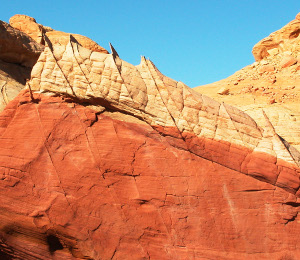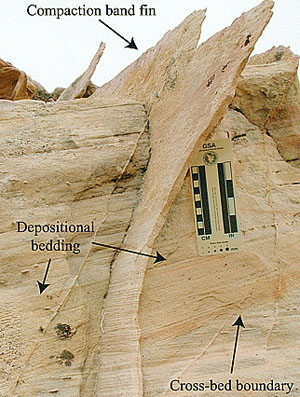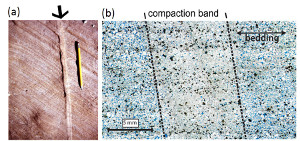| |||||||
|
|
|||||||
|
|
|||||||
| Compaction Bands | |||||||
|
Compaction bands are deformation bands that have negative volumetric change with respect to the undeformed state and that show no significant macroscopic shear offset. Figure 1 and Figure 2 show a set of compaction bands at high-angle to bedding in Aztec Sandstone in Valley of Fire State Park, Nevada, a type locality for compaction bands in silica clastic rocks. Similar to other structural elements, compaction bands occur in sets and multiple sets as will be discussed in other related concepts and links. Due to their higher stiffness, compaction bands have higher resistance to erosion and therefore, they generally stand out as ribs or fins as seen in the figures presented above. A closer view of the intersections of the fins and the cross beds both in outcrop and in thin sections do not show any noticeable offset across the band (Figure 3). There are also shear bands in the Aztec Sandstone within the Park, and the compaction bands are somewhat thicker, up to a few centimeters, compared with the average thickness of about a few millimeters of the shear bands at the same outcrop. Please see the link under case studies to see comparative examples. Porosity, permeability, and pore connectivity in compaction bands of Valley of Fire State Park decrease as reported by several researchers (Sternlof et al., 2004; 2006; Aydin and Ahmadov, 2009; Sun et al., 2011; Deng et al., 2012; 2015; 2016), which will be discussed under 'Petrophysical Properties of Compaction Bands.' It has been proposed that deformation bands can significantly affect bulk sandstone permeability when present as pervasive arrays, with important implications for the management of both groundwater and hydrocarbon resources, and contaminant remediation. | |||||||
| Reference: |
|||||||
| Aydin, A., Borja, R., Eichhubl, P., 2006 Aydin, A., Ahmadov, R., 2009 Deng, S., Aydin, A., 2012 Deng, S., Zuo, L., Aydin, A., Dvorkin, J., Mukerji, T., 2015 Deng, S., Jiang, R., Karimi-Fard, M., Aydin, A., 2016 Sternlof, K.R., Chapin, J.R., Pollard, D.D., Durlofsky, L.J., 2004 Sternlof, K.R., Karimi-Fard, M., 2005 Sun, W., Andrade, J. E., Rudnicki, J.W., Eichhubl, P., 2011 |
|||||||
|
Readme | About Us | Acknowledgement | How to Cite | Terms of Use | Ⓒ Rock Fracture Knowledgebase |
|||||||


